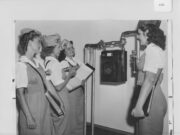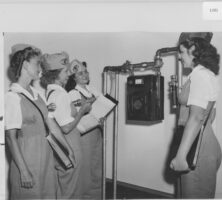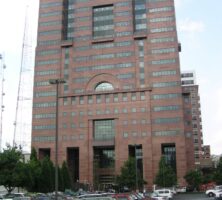In February 1856 the Atlanta Gas Light Company was incorporated to provide gas lighting to the city of Atlanta. One of Georgia’s oldest companies, Atlanta Gas Light has provided gas light, heat, and power to many of Atlanta’s homes and still delivers natural gas to 1.5 million homes in Georgia. The company is a division of AGL Resources, a publicly traded multistate energy company.
The Early Years
When Atlanta’s leaders decided to light the city’s first gas streetlight on December 25, 1855, they sparked a new era in the city’s early history. Prior to the advent of gas or electric streetlights, a walk through the rapidly growing young metropolis after dark could be dangerous, with obstructions and holes nearly invisible on the unlit dirt streets.
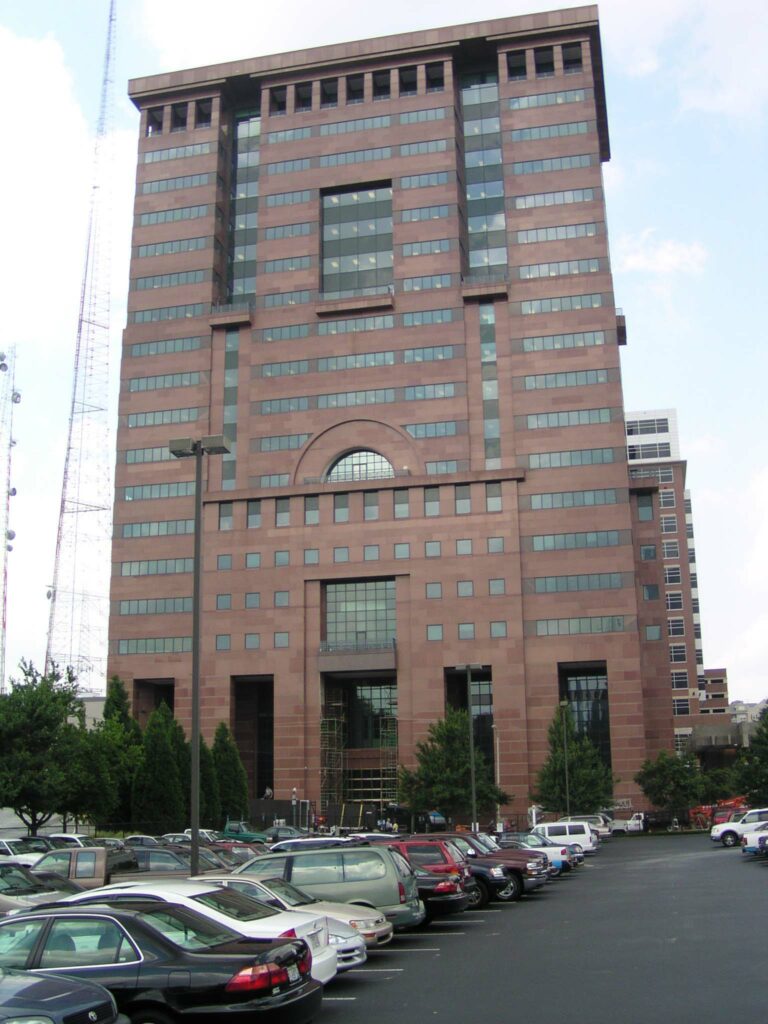
Courtesy of AGL Resources
Industrialist William Helme of Philadelphia, Pennsylvania, founded Atlanta Gas Light Company after a sawmill he owned in Brunswick burned to the ground. Helme made an agreement with the Atlanta City Council to construct a coal-burning gas plant, commonly known as a gasworks. (Prior to the discovery and harnessing of natural gas, gas companies relied on factories that burned coal or boiled water to create gas.) The city, in turn, agreed to use at least fifty streetlights and pay thirty dollars a year for the gas to light the lamps. The city also agreed to give the company exclusive rights for fifty years to light Atlanta’s streets. On April 6, 1855, both parties agreed to the terms, and construction of Atlanta’s first gas plant began.
The popularity of gas lights quickly grew, and the company’s shareholders reaped handsome rewards. Early challenges included keeping the lamps lit and in working order, as well as determining whether Atlanta Gas Light employees or city police officers would light them each night.
In the midst of the Civil War (1861-65), the city briefly took over the company because a majority of the company’s stock was still owned by Helme and Northern investors, who were deemed “alien enemies” by a court decision. The company was ruined when Union general William T. Sherman’s troops burned its gasworks to the ground in 1864.
Like the rest of Atlanta and the South, Atlanta Gas Light recovered unevenly in the Reconstruction years following the war, alternately prospering and foundering. By 1880 economic conditions had allowed all of the city’s lamps to be turned back on.
But several new challenges loomed on the horizon. On July 21, 1881, the Atlanta City Council gave permission for the first electric light to be lit, but it took more than two years for the Georgia Electric Light Company to begin setting up its electric lights. At the time, Atlanta Gas Light had 426 gas lamps on the city’s streets. The city also cut its direct ties with Atlanta Gas Light by the late 1880s, selling its shares of stock for various purposes, including the construction of buildings for the institution that eventually became the Georgia Institute of Technology.
The Welsbach Mantle, a unique type of gas-burning lamp, allowed gas lamps to be used effectively in homes and competed—for a time—with electric streetlamps. Recognizing the inevitable dominance of electric light, gas companies began focusing on other uses for gas in the home, including indoor heating, water heating, and cooking. Since most homes were not wired for electricity, gas lighting remained a popular choice in Atlanta homes.
Expansion and War
In 1889 the company’s directors accepted an offer from United Gas Improvement Company to acquire Atlanta Gas Light. United Gas was an active owner of gas companies around the country. In 1903 United Gas sold Atlanta Gas Light to Georgia Railway and Electric (GR & E), the predecessor of Georgia Power. Georgia Power owned the company until 1929. The company’s next owner, Central Public Service Company, sought to bring natural gas to Atlanta, and by 1930 natural gas was flowing through the system.
The gas pipeline ran from Louisiana to Georgia and offered gas to industry, homes, and public facilities. To accommodate the “great changeover” to natural gas, the company had installed a nearly new distribution system. It now offered a seemingly unlimited supply of high-quality product at low prices, and the company’s amended charter allowed it to serve the entire state. Unfortunately, the timing was poor; the company would have to wait through the Great Depression to reap the full rewards of its investment. During the 1930s, the company managed to add customers and expand its service to towns in the greater Atlanta area: Avondale Estates, College Park, Decatur, East Point, Hapeville, Marietta, and Smyrna. In 1941 Consolidated Electric and Gas consolidated its gas subsidiaries in several Georgia towns under the Atlanta Gas Light banner.
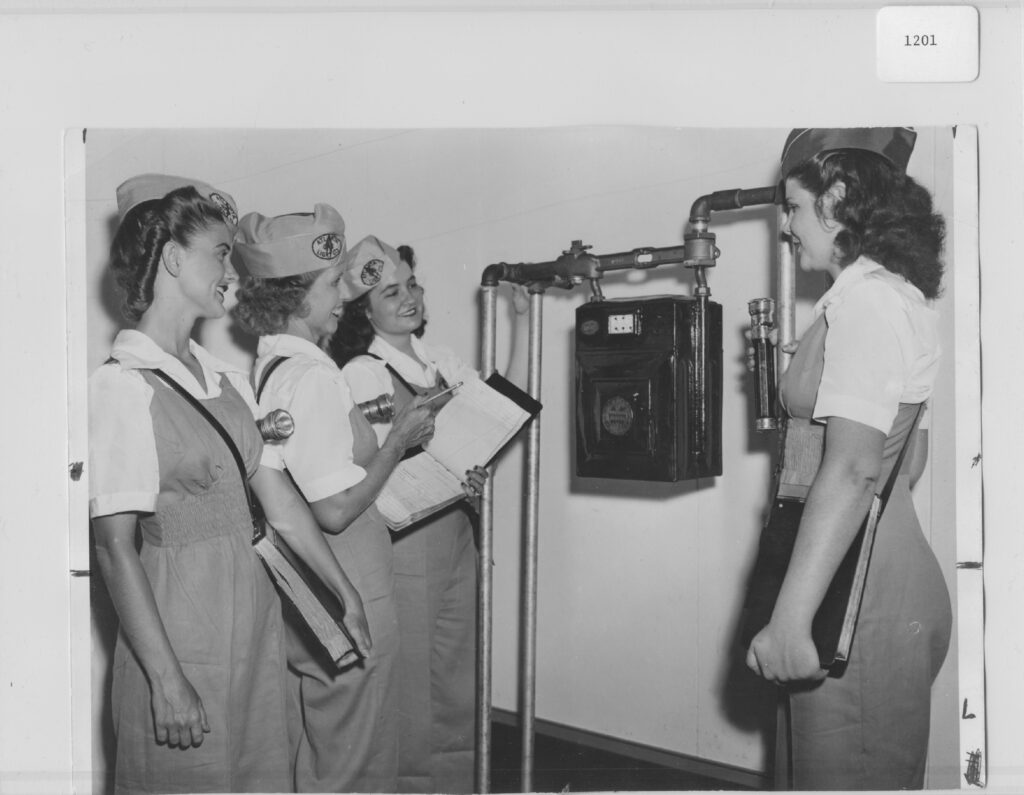
Courtesy of AGL Resources
Throughout World War II (1941-45), the company struggled to maintain service while nearly half of its employees served in the military and as raw materials were diverted to the war effort. But by the end of the war, following mergers, consolidations, and organic growth, Atlanta Gas Light served more than 123,000 customers around the state.
A Modern Company
Business boomed as soldiers returned home and established households. In 1949 the company had its most successful year ever for the sale of gas ranges, refrigerators, water heaters, and other gas appliances. In 1947 Central Public Service divested the company, spinning it off with its own stock offering. After fifty-eight years of outside ownership, Atlanta Gas Light was back on its own.
By its 100th anniversary in 1956, the company was thriving. With the appointment of William L. Lee as president in 1961, a period of rapid growth began. Lee aggressively expanded the company’s infrastructure and ramped up its sales efforts. During this period, the company changed its name to Georgia Natural Gas, reflecting the service it provided outside the metropolitan Atlanta area, and adopted a stylized gas-flame logo for its various divisions.
Atlanta Gas Light also implemented its highly successful Shining Light Award program in the early 1960s. Each winner of this community service award may choose a location in which to have a light installed. Notable winners include Hank Aaron, Ivan Allen Sr., William B. Hartsfield, Bobby Jones, Bernie Marcus, Ralph McGill, Margaret Mitchell, and Robert Woodruff.
The company’s growth and challenges mirrored those of Georgia through much of the 1960s and 1970s. The state’s rapid growth provided a ready pool of new customers for the company. But in the 1970s the gas industry was not immune from the national energy crisis. Historically low prices of natural gas discouraged exploration by producers, crimping proven supplies. Increasing use coupled with fewer new sources caused painful price increases for consumers and considerable difficulties for Atlanta Gas Light. The company was forced to begin charging for service calls and asked the Georgia Public Service Commission for several rate increases. By the 1980s the market came back into balance.
Deregulation
By 1996 Atlanta Gas Light was again a division of a holding company. As Atlanta Gas Light had grown, a parent company called AGL Resources was formed to serve as a holding company for the myriad companies under the Atlanta Gas Light and Georgia Natural Gas umbrellas and to allow expansion outside the state. This move also put Atlanta Gas Light in position to compete during deregulation, a trend sweeping the country.
In 1997 the Georgia General Assembly passed the Georgia Natural Gas Competition and Deregulation Act. Under this act, customers could choose to buy gas directly from one of several marketers that actually supplied the gas to Atlanta Gas Light, which continued to control and maintain the city’s gas infrastructure. AGL Resources has its own gas marketing entity. By 2003 Atlanta Gas Light was the largest natural-gas distributor in the Southeast, providing delivery service to more than 1.5 million customers throughout Georgia.
John W. Somerhalder II is president and chief executive officer of AGL Resources.


